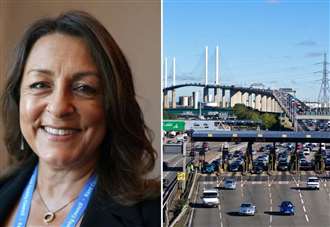Kent should receive a cut of the new Dart Charge fee when it comes into force in September, according to the leader of the county council.
Cllr Linden Kemkaran has written to the roads minister asking for a proportion of the toll to use the Dartford Crossing to ease the cost burden of maintaining the county’s roads.

The fee for car users will jump 40% from £2.50 to £3.50 on September 1, although pre-pay account holders will receive a 70p discount.
Cllr Kemkaran says that Kent residents, apart from those who live in Dartford and receive a reduced annual tariff, have “no viable” alternative.
That’s because, she says, driving through Greater London risks either incurring the ULEZ emissions charge if driving a non-compliant vehicle, or potentially paying even more (£4 each way) to use the Blackwall or Silvertown tunnels.
The Reform leader says this will hit the “very poorest” in the county.
In a letter to Lillian Greenwood, the Minister for Future of Roads, Cllr Kemkaran complains: “This is hardly equitable.
“It will also increase costs to the supply chain which will be passed onto customers – furthering the cost-of-living pressures for so many hard-working people.”
She adds: “Given the impact on Kent is so great, there is a strong argument that KCC, as the Highways authority for Kent, should be passported a proportion of this money each year to aid the upkeep of the road network.

“When one considers the amount of foreign traffic that transverses Kent’s roads, alongside the amount of traffic from other counties within the UK, it is fair to say Kent is the Gateway County.
“And with that in mind we feel that lack of any financial benefit KCC receives from the Dart Charge needs to be considered as we struggle to maintain our road networks.”
Cllr Kemkaran adds: “Clearly the crossing is not on the cusp of losing money.”
When the increase was announced last month, Mrs Greenwood told the House of Commons: “Current charging levels are no longer sufficient to achieve their stated aim of managing demand so that the crossing works well for users and local people.
“The need to increase the charges to manage traffic highlights the need for the additional capacity that (the) Lower Thames Crossing will provide.
But Cllr Kemkaran argues: “For the increase to be intended to manage demand, without an alternative route there is no way of managing routing, so it will only suppress the journeys for the very poorest in our society.”

She goes on: “Given the impact on Kent is so great, there is a strong argument that KCC, as the highways authority for Kent, should be passported a proportion of this money each year to aid the upkeep of the road network.
“When one considers the amount of foreign traffic that transverses Kent’s roads, alongside the amount of traffic from other counties within the UK, it is fair to say Kent is the ‘Gateway County’.
“And with that in mind we feel that lack of any financial benefit KCC receives from the Dart Charge needs to be considered as we struggle to maintain our road networks.
“This new funding stream would enable us to make a tangible difference to the condition of our Local Road Network or help fund major improvement schemes on the Strategic Road Network, including funding towards the new Lower Thames Crossing – unlocking growth and opportunities, and helping to offset the detrimental impact of the increased crossing charge.”
The KCC leader said that the toll was only meant to stay in place until the crossings were paid for but the policy was subsequently changed.
In outlining the reasons for the hike in charges, Mrs Greenwood told MPs in June: “To manage demand and protect the crossing’s role as a vital component of the nation’s economic infrastructure, a user charge has been collected at the crossing since 2003.

“In 2014, the tollbooths were removed to help make journeys smoother and the charge was increased to help manage increased demand.”
This was the last time that charges were increased for all vehicles.
In the 11 years since, demand at the crossing has grown 7.5%, with the crossing now used by an average of more than 150,000 vehicles every day, and up to 180,000 vehicles on the busiest days.
Mrs Greenwood added: “These traffic levels are well in excess of the crossing’s design capacity, causing delays for drivers using the crossing, congestion and journey disruption to drivers on the M25 and a range of knock-on impacts for local communities.”
When asked to respond to Cllr Kemkaran’s request for a “passported portion” of the funds a Department for Transport spokesman said: “The increase in charges at Dartford is to secure the effective operation of the Crossing so that it works well for the drivers who use it and the local residents affected by it.
“The need to increase the charges to manage traffic highlights the need for the additional capacity the Lower Thames Crossing can provide, for which the government has allocated £590m in funding.”
